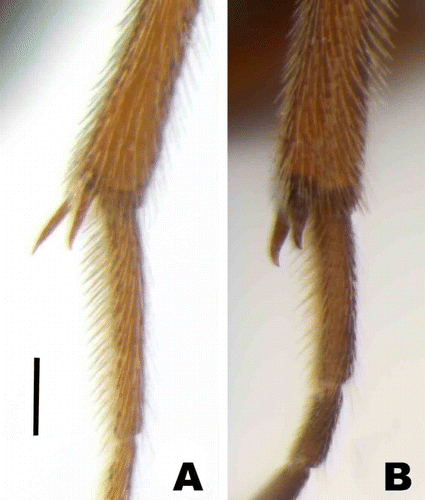Abstract
A taxonomic study of the Palearctic species of the genus Brachyserphus is presented. Two species are newly described as B. acuticaudatus sp. n. and B. semipunctatus sp. n. from South Korea and the Russian Far East. B. striatopropodeatus (Kolyada 1997 syn. n.) is synonymized under B. lucens (Provancher 1883) and a key to the Palearctic species is provided.
Introduction
The genus Brachyserphus Hellén (Proctotrupidae) consists of 15 species worldwide (including a two new species described below; Kolyada Citation1997; Townes and Townes Citation1981), but distributed primarily in the Northern Hemisphere (Townes and Townes Citation1981). Previously, only four Palearctic species of Brachyserphus were reported: the Holarctic B. parvulus (Nees), the extremely rare European B. laeviceps (Thomson) (Johnson Citation1992; Kozlov Citation1978; Pschorn-Walcher Citation1964; Townes and Townes Citation1981), and two species from the Russian Far East, B. striatopropodeatus Kolyada and B. nudipleuralis Kolyada (Kolyada Citation1997).
The biology of this genus is poorly studied. The larvae of the coleopteran families Erotylidae, Phalacridae, Melandryidae, Mycetophagidae, and Nitidulidae (Hoebeke and Wheeler Citation1990; Townes and Townes Citation1981; Williams et al. Citation1992) were mentioned as hosts.
In this study, we provide a revised key to the Palearctic species of the genus Brachyserphus, descriptions of B. acuticaudatus sp. n. and B. semipunctatus sp. n. from South Korea and the Russian Far East, and a new synonym on B. lucens (=B. striatopropodeatus syn. n.).
Materials and methods
Specimens studied were collected with Malaise traps (MT) and by sweeping. The morphological terms and characters used follow Townes and Townes (Citation1981) and Mikó et al. (Citation2007), with additions. All photographs were obtained using a Leica M125 stereomicroscope equipped with a Leica DFC450 camera. The montage of the image layers was prepared using Helicon Focus 5.0.
Collecting sites were abbreviated based on the provinces of South Korea in which they were located as follows: (GN), Gyeongsangnam-do; (GB), Gyeongsnagbuk-do; (JJ), Jeju-do; (JB), Jeonrabuk-do; (CN), Chungchongnam-do; (GG), Gyeonggi-do; (GW), Gangwon-do. Specimens are deposited in the following institutions: AEI, American Entomological Institute, Gainesville, Florida, USA; BMNH, British Museum of Natural History, London, UK; CNCI, Canadian National Collection of Insects, Ottawa, Canada; NHRS, Naturhistorska Riksmuseet, Stockholm, Sweden; ULQC, University of Laval, Quebec, Canada; YUGK, Animal Systematic Laboratory of Yeungnam University, Gyeongsan, South Korea; ZISP, Zoological Institute, St. Petersburg, Russia. The names of Russian collectors are abbreviated as follows: SAB, S.A. Belokobylsky; DRK, D.R. Kasparyan; VIT, V.I. Tobias.
Taxonomy
Genus
Brachyserphus
Hellén
Brachyserphus Hellén, Citation1941: 42.
Type species: Codrus parvulus Nees von Esenbeck, Citation1834, by original designation.
Diagnosis. Front wing 1.3–3.5 mm long. Body stout and somewhat compressed laterally. Head broad, transverse. Clypeus with apical margin simple and not bordered by longitudinal carina; distance between antennal sockets equal to their diameter. Distance from margin of clypeus to center of tentorial pits less than distance to lower margin of antennal sockets by 1.0–1.5. Mandible moderately stout, with single pointed tooth. Gena without sulcus. Occipital carina present but not reaching hypostomal sulcus. Male flagellum without noticeable tyloids. Pronotum with prominent pronotal shoulder. Epomia present. Pronotal shoulders pointed dorsally and laterally with carina on edge. Scutellar pit without inner longitudinal carinae. Notaulus present only anteriorly and about as long as tegula. Horizontal mesopleural groove complete and strong. Stigma very deep, r-rs (vertical part of radius) not clear, radial vein extending through lower margin of stigma. Costal vein ending at apex of radius. Metatibial spur at most 0.5 length of basitarsus. Metasoma without distinct petiole. Ovipositor sheath 0.4–0.9 times as long as metatibia, stout, smoothly rounded apically or more or less acuminate, covered with erect hairs, especially in the lower part.
Remarks. The species of the genus Brachyserphus are difficult to identify because of the wide range of variations in their characteristics. True identification is possible when a long series of specimens are used. Males are still practically unidentifiable; so only some of them were keyed (Townes and Townes Citation1981).
Key to the Palearctic species of Brachyserphus
1. Metatibia with spurs hooked, short, and thickened (B). Ovipositor sheath with apex smoothly rounded ventrally (A). Length of ovipositor sheath 0.88 times as long as metatibiaB. lucens
- Metatibia with spurs normally shaped, straight, and thin (A). Ovipositor sheath with apex more or less acuminate ventrally (B–G). Length of ovipositor sheath is less than 0.88 times as long as metatibia2
2(1). Pronotal shoulders and side of pronotum with several horizontal and oblique wrinkles (C). Metapleurum with metapleural epicoxal carina. Length of ovipositor sheath is 0.53 times as long as metatibia (E) B. hawaiiensis
- Pronotal shoulders and side of pronotum without horizontal and oblique wrinkles (A, B, D)3
3(2). Metapleurum without metapleural epicoxal carina (D). Length of ovipositor sheath is 0.55–0.6 times as long as metatibia (B)B. nudipleuralis
- Metapleuron with metapleural epicoxal carina sometimes only in apical one third (A–C) 4
4(3). Female only. Ovipositor sheath markedly widened in apical half (F).B. laeviceps
- Ovipositor sheath almost the same width in apical half5
5(4). The punctated area in the anterior part of the fifth tergite neither reaching one-half of its length nor including the row of hairs in the posterior part of tergite (B). The ninth flagellomere of antennae a little longer and narrower, 1.7 as long as broad (D)B. semipunctatus sp. n.
- The punctated area in the anterior part of the fifth tergite reaching two-third of its length and includes or reaches the row of hairs in the posterior part of tergite (A). The ninth flagellomere of antennae a little shorter and wider, 1.2–1.3 as long as broad (C)6
6(5). Ovipositor sheath slightly curved, and narrowly pointed apically (D). Maxillary palpus dark-brownB. acuticaudatus sp. n.
- Ovipositor sheath widely pointed apically (C). Maxillary palpus yellow, rarely light-brown B. parvulus
Brachyserphus acuticaudatus Kolyada sp. n.
(B, D, A, C,B)
Type material
Holotype: female. RUSSIA. Primorsk reg.: ‘RUSSIA, Primorskii krai/10 km South-East Chernogolovka/26–29.viii.1998/S.A. Belokobylsky.’ (ZISP), ‘HOLOTYPE/Brachyserphus/acuticaudatus Kolyada sp. n.’ (ZISP). Condition: good whole.
Figure 2. Mesosoma, lateral view: (A) B. parvulus, (B) B. acuticaudatus sp. n., (C) B. hawaiiensis, (D) B. nudipleuralis. Scale bar (A–D): 0.5mm.
*e: epomia, mec: metapleural epicoxal carina.
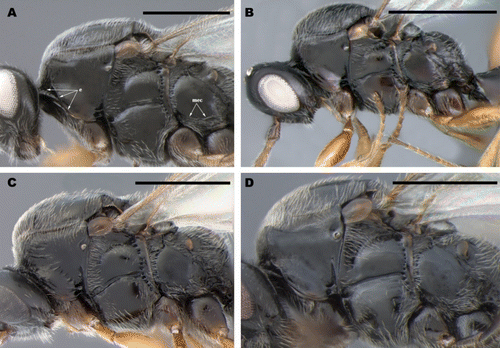
Paratypes. RUSSIA. Buryatia: 1♀, ‘Kyakhta, Dungaj, Kudara-somon/8–9.viii.1973/D.R. Kasparyan’ (ZISP); Amursk reg.: 1♀, ‘Zeya Reserve, cordon 52 km, 2.ix.1981/V. Alekseev’ (ZISP); Khabarovsk reg.: 1♀, ‘Amur River, Udyl Lake/29–31.viii.1970, D.R. Kasparyan’ (ZISP); 1♀, ‘Khekhzir Mts, 3.vii.1982/D.R. Kasparyan’ (ZISP); Primorsk reg.: 1♀, ‘Vladivostok, 11.ix.1982/V.I. Tobias’, 1♀, ‘24.viii.1988/S.A. Belokobylsky’ (ZISP); 1♀, ‘15 km E Spassk, 16.ix.1988/S.A. Belokobylsky’ (ZISP), 1♀, ‘Spassk, 20–22.ix.1988/S.A. Belokobylsky’, 1♀, ‘25.vii.1996/S.A. Belokobylsky’ (ZISP); 1♀, ‘20 km SE Ussurijsk/GTS, 28–31.viii.1978/D.R. Kasparyan’, 1♀, ‘2–3.viii.1991/S.A. Belokobylsky’ (ZISP); 2♀, ‘Anisimovka, 4.ix.1982/V.I. Tobias’, 1♀, ‘Anisimovka, 4–7.viii.91/S.A. Belokobylsky’, 1♀, ‘5–9.vii.1993/S.A. Belokobylsky’ (ZISP); 1♀, ‘Kedrovaya Pad' Reserve/27–30.viii.1995, S.A. Belokobylsky’ (ZISP); 1♀, ‘Novokachalinsk, Khanka Lake/29.viii.1987, S.A. Belokobylsky’, 1♀, ‘Novokachalinsk, Khanka Lake/7.viii.2006, S.A. Belokobylsky’ (ZISP); 1♀, ‘Khasan, 11.viii.1984/A. Kirejchuk’ (ZISP); 1♀, ‘10 km SE Chernogolovka/26–29.viii.1998, S.A. Belokobylsky’ (ZISP); Sakhalin reg.: 1♀, ‘Kunashir I., Golovnina Mt./25–27.vii.1981, S.A. Belokobylsky’ (ZISP). SOUTH KOREA. (GN): 1♀, ‘Dapcheon-ri, Ibanseong-myeon,/Jinju-si, 27.vi–4.vii.2005,/B.K. Ahn’ (YUGK); 1♀, ‘Samjeong-ri, Macheon-myeon, /Hamyang-gun, Jirisan, /22.vi–6.vii.2003’ (CNCI); (GW): 1♀, ‘Woljeongsa, Dongsan-ri, /Odaesan, 19.vii–18.viii.2003’ (CNCI).
Figure 3. Ovipositor sheath, lateral view: (A) B. lucens, (B) B. nudipleuralis, (C) B. parvulus, (D) B. acuticaudatus sp. n., (E) B. hawaiiensis, (F) B. laeviceps, (G) B. semipunctatus sp. n. Scale bar (A–G): 0.5mm.
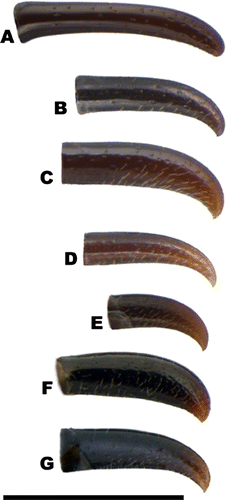
Description. Female.
Body length 3.0–3.2 mm, Forewing length 2.0–2.2 mm. Antenna short, length to width ratio of second flagellomere 1.67–2.0. Pronotum and pronotal tubercle smooth, without wrinkles. Epomia not interrupted and dorsally connected with carina to pronotal shoulder. Metapleurum with developed metapleural epicoxal carina. Propodeum just behind spiracle and apical area of dorsum finely reticulate. Propodeum dorsolaterally with ca. 35–40 hairs. Ratio of ovipositor sheath to metatibia length 0.5–0.6. Ovipositor sheath slightly curved, and narrowly pointed apically, with hairs on its lower surface ca. 0.25 as long as sheath height.
Color. Body black. Labrum, mandibles, tegula, and legs except coxa yellow or light brown. Coxae black to dark brown. Maxillary palpus of dark-brown. Scapus almost always darkened ventrally, remainder of antenna yellowish becoming darker towards apex.
Figure 4. Fifth tergite and ninth flagellomere of antennae in lateral view: (A, C) B. parvulus or B. acuticaudatus sp. n., (B, D) B. semipunctatus sp. n. Scale bar (A–D): 0.5mm.
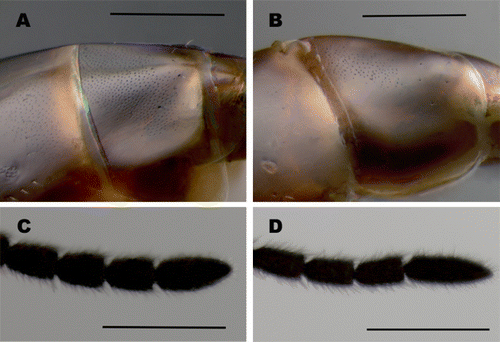
Male unknown.
Comparison. Similar to B. parvulus (Nees von Esenbeck 1834) in many characteristics, but differs by the slightly curved and narrowly pointed ovipositor sheath apex and maxillary palpus of dark-brown color.
Distribution. Far East of Russia, South Korea.
Brachyserphus hawaiiensis (Ashmead Citation1901)
(C, E, C)
Proctotrypes hawaiiensis Ashmead, Citation1901: 294.
Holotype: female, (BMNH).
Material examined (non-type)
SOUTH KOREA. (JJ): 1♀, Jeolmul-Oreum Bonggae-dong Jeju-si, 9–16.vii.2005, C.H. Sin (YUGK); USA. Hawaii: 48♀, Hawaiian Islands, Volcano N.P., 20.xi.1989, MT, J.C. Allen (CNCI).
Distribution. South Korea, Hawaii.
Remarks. This species was previously only identified in Hawaii but was recorded for the first time in the Palearctic region as having been collected at Jeju Island, South Korea. Type material was examined by other well known vouchers.
Brachyserphus laeviceps (Thomson 1858)
(F)
Proctotrupies laeviceps Thomson, Citation1858: 416.
Holotype: female, (NHRS)
Material examined (non-type)
RUSSIA. [European part]: Yaroslavl reg.: 1♀, Berditsyno, 24.viii.1894, A. Yakovlev (ZISP); Moscow reg.: 2♀, 2♂, Pavlovskaya Sloboda, 1.vii.1995, V. Kolyada (ZISP); Kareli[0]a: 2♀, West Kivach, 31.viii.2003, A. Humala (ZISP).
Distribution. North and Central Europe (Hedqvist Citation2007; Townes and Townes Citation1981; Zetel Citation1991), European Part of Russia (Kolyada Citation1997; Kozlov Citation1978).
Remarks. Type material was examined by other well known vouchers.
Brachyserphus lucens (Provancher 1883)
(B, A, D)
Megaspilus lucens Provancher, Citation1883: 33.
Holotype: female, (ULQC) (not examined).
Brachyserphus striatopropodeatus Kolyada, Citation1997: 1. syn. n.
Type material examined
Brachyserphus striatopropodeatus Kolyada. Holotype: female. RUSSIA. Primorsk reg.: ‘RUSSIA, Primorskii krai/Anisimovka, 4–5.ix.1988/S.A. Belokobylsky leg.’, ‘HOLOTYPE/Brachyserphus/striatopropodeatus Kolyada sp. n.’ (ZISP). Condition: good, no part missing.
Figure 5. Habitus of Brachyserphus spp. (female), lateral view: (A) B. parvulus, (B) B. acuticaudatus sp. n., (C) B. hawaiiensis, (D) B. lucens, (E) B. nudipleuralis, (F) B. semipunctatus sp. n., Scale bar (A–F): 1.0mm.
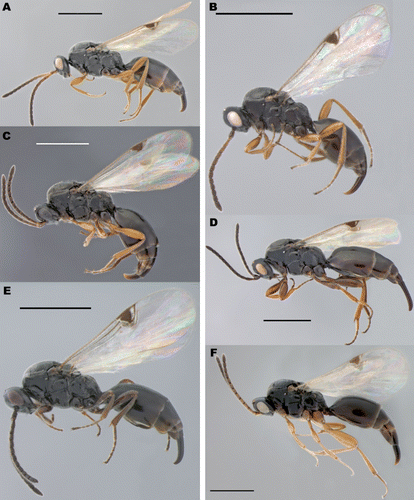
Paratypes. RUSSIA. Primorsk reg.: 1♀, ‘Vladivostok, 24.viii.1988/S.A. Belokobylsky’ (ZISP); 1♀, ‘Anisimovka, 4–5.ix.1988/S.A. Belokobylsky’ (ZISP).
Additional material examined (non-type)
RUSSIA. [Far East]: Primorsk reg.: 1♀, Khasan, 5.x.1980, Kupyanskaja (ZISP); 5♀1♂, 15 km SW Slavyanka, Ryazanvka, 14–23.ix.1995, SAB (ZISP); 1♀1♂, 25 km SW Slavyanka, 18–20.viii.1998, SAB (ZISP); 1♀, Khasan Lake, 30.viii.2003, SAB (ZISP); 2♀, 10 km SE Chernogolovka, 26–29.viii.1998, SAB (ZISP); 2♀, Vladivostok, 4–7.ix.2003, SAB (ZISP). USA. Michigan, 1♀, Ann Arbor, 5–6.x.1975, M.G.Fitton (AEI).
Distribution. Holarctic: Russia (Far East), North America.
Diagnosis. After studying a large series of specimens of B. striatopropodeatus it became obvious that the primary distinctive characteristic of this species, the longitudinal reticulation on propodeum laterally, is variable The form of ovipositor sheath, and thick, hooked and short spurs on metatibia, indicate it belongs to the Nearctic species B. lucens.
Brachyserphus nudipleuralis Kolyada, Citation1997
(D, B, E)
Brachyserphus nudipleuralis Kolyada, Citation1997: 1.
Type material examined
Brachyserphus nudipleuralis Kolyada. Holotype: female. RUSSIA. Primorsk reg.: ‘RUSSIA, Primorskii krai/Anisimovka, 5–9.vii.1993/S.A. Belokobylsky leg.’, ‘HOLOTYPE/Brachyserphus/nudipleuralis Kolyada sp. n.’ (ZISP). Condition: good, whole.
Paratypes. RUSSIA. Primorsk reg.: 1♀, ‘Anisimovka, 26–27.vi.1996/S.A. Belokobylsky’ (ZISP); 1♀, ‘Vladivostok, 3.vii.1996/S.A. Belokobylsky’ (ZISP); 1♂, ‘20 km SE of Ussurijsk/Gornotayozhnoe, 4–5.viii.1991/S.A. Belokobylsky’ (ZISP); 4♀1♂, ‘Novokachalinsk/Khanka Lake, 7.viii.2006/S.A. Belokobylsky’ (ZISP); Sakhalin reg.: 2♀, ‘Kunashir I., 5.ix.1976/L. Danilovich’ (ZISP); 1♀, ‘Tretyakovo 3–10.viii.1973/D.R. Kasparyan’ (ZISP).
Additional material examined (non-type)
RUSSIA. Primorsk reg.: 1♀, Vladivostok, 24.viii.1988 SAB (ZISP); Anisimovka, 1♂, 5–9.vii.1993, 9♀, 6–7.viii.1993, SAB (ZISP); 1♀, 10 km SE Chernogolovka, 26–29.viii.1998, SAB (ZISP); 1♀, 25 km SW Slavyanka, 18–20.viii.1998, SAB (ZISP).
Distribution. Russia (Far East).
Brachyserphus parvulus (Nees von Esenbeck 1834)
(A, C, A, C, A)
Codrus parvulus Nees von Esenbeck, 1834: 360.
Syntypes: ♂♀
Additional material examined (non-type)
RUSSIA. [European part]: Moscow: 2♀, 19.v.1996, V. Kolyada, & I. Blonski (ZISP); Moscow reg.: 1♂, Stupino, 10.x.1994, V. Kolyada (ZISP); Yaroslavl reg.: 1♀, Yaroslavskij ujezd, Berditsyno, 23.vii.1897, A. Yakovlev (ZISP); Novgorod reg.: 20 km NW Pestovo, 9♀, 5.viii.1990, 1♀, 14.vii.1991, VIT (ZISP); Arkhangelsk reg.: 1♂, 25 km SE Arkhangelsk, 7.viii.1977, DRK (ZISP); Murmansk reg.: 2♀, Murmansk, 12.viii.1923, Fridolin (ZISP); 1♀, Seidozero 10 km S. Lovozero, 24.vii.1974, DRK (ZISP); Komi: 1♀, Uhta, 31.viii.1972, DRK (ZISP); Perm reg.: 1♂, Lysva Distr., Kamenka, 5.viii.1963, V. Zherikhin (ZISP); Krasnodar reg.: 1♀, Sochi, Lazorevskoje, 11–6.ix.1981, VIT (ZISP); South Ossetiya: 1♂, Ertzo Lake, 10.viii.1984, DRK (ZISP); [Siberia]: Evenkiya: 1♀,1♂, Centralsiberian Reserve, 27.vii.2003, A. Kuvaev (ZISP); [Far East]: Khabarovsk reg.: 1♂, Khekhzir Mts, 28–30.vii.1983, DRK (ZISP); Primorsk reg.: 1♀, Vladivostok, Akademgorodok, 18.vi.1972, M. Kozlov (ZISP); Vladivostok, 1♀, 11.ix.1982, VIT, 1♀, 29–30.viii.1985, VIT, 1♀, 4–5.ix.1985, VIT, 1♀, 24.viii.1988, SAB (ZISP); Volno-Nadezhdinskoe, 1♂, 4.vii.1996, SAB (ZISP); 4♀, 15 km NW Artem, 6–7.ix.1988, SAB (ZISP); 1♀, 20 km SE Ussurijsk, GTS, 28–31.viii.1978, DRK (ZISP); 1♀, 4–5.viii.1991, SAB (ZISP); 2♀,1♂, Ussuriiskii Reserve, 26–30.vii.1972, M. Kozlov (ZISP); 10 km SE Chernogovka, 1♂, 27–29.vii.1996, SAB, 5♀6♂, 26–29.viii.1998, SAB (ZISP); 3♀,8♂, Spassk, 10.ix.1981, SAB (ZISP); Spassk, 1♀, 15–16.ix.1987, SAB, 2♀, 11.ix,1988, SAB, 6♀,6♂, 17–19.viii.1991, SAB, 1♀, 10–13.vii.1993, SAB, 1♂, 17–21.vi.1996, SAB (ZISP); 1♂, 40 km E Chuguevka, 23–25.viii.1978, DRK (ZISP); 1♀, Lazo Reserve, Ta-Chingouz, 16.ix.1948, V. Gussakovskij (ZISP); 1♀, Molchanovsk, 18.vi–1.vii.1972, M. Kozlov (ZISP); 4♂, 10 km SW Sokolcha, 22–24.vii.1993, SAB (ZISP); 1♂, 15 km NWW Partizansk, Fridman, 28.vi.1996, SAB (ZISP); 1♂, 15 km NE Partizansk, Frolovka, 7–8.vii.1996, SAB (ZISP); 1♂, 20 km NNE Partizansk, 10.vii.1996, SAB (ZISP); 1♀, 10 km SSW Partizansk, 13.vii.1996, SAB (ZISP); Anisimovka, 2♀,1♂, 11–13.ix.1978, DRK, 1♀, 4.ix.1982, VIT, 4♂, 10.viii.1991, SAB, 1♂, 5–9.vii.1993, 1♀, 6–7.viii.1993, SAB (ZISP); Novokachalinsk, 1♀, 29.viii. 1987, 1♂, 21–23.vii.1995, SAB (ZISP); 1♀, Novokachalinsk, Khanka Lake, 7.viii.2006, SAB (ZISP); 1♀, Barabash-Levada, 2–4.ix.1978, DRK (ZISP); 1♀, Kedrovaya Pad' Reserve, 21–23.ix.1978, Zinovjev (ZISP); 1♀, 15 km SW Slavyanka, 16.vi.1993, SAB (ZISP); Sakhalin reg.: Sakhalin I., Novoaleksandrovka near Yuzno Sakhalinsk, 1♀, 7.ix.1973, DRK (ZISP), 1♂, 13–14.vii.1981, SAB (ZISP); 1♀,1♂, Kunashir I., Golovnina Mt., 24–26.vii.1973, DRK (ZISP); Kamchatka reg.: 3♂, Kozyrevsk, 12–24.vii.1985, SAB (ZISP). GEORGIA: 1♀, Sukhumi, 30.ix.1932, Belizin (ZISP); 1♀, Borjomi, 19–22.vii.1981, Gurasashvili (ZISP); 2♂, Kazbegi, 4–18.viii.1982, Dbar (ZISP); 1♀, Tsagveri, 14.ix.82, Dbar (ZISP). KAZAKHSTAN: 1♀, Kazakh Altai, 7 km SW Upper Khubinka, Uba River, 11.viii.1983, SAB (ZISP).
SOUTH KOREA. (GN): Dapcheon-ri Ibanseong-myeon Jinju-si, 8♀, 27.vi–4.vii.2005, 1♀, 25.vii–11.viii.2005, B.K. Ahn (YUGK); Samjeong-ri, Macheon-myeon, Hamyang-gun, Jirisan, 5♀, 15.ix–13.x.2002, 1♀, 15–22.vi.2003, 1♀, 22.vi–6.vii.2003, (CNCI); (CN): 1♀, Wolpyeong park, Wolpyeong-dong, Seo-gu, Daejeon-si, 20.vi–10.viii.2008, J.W. Lee (YUGK); 1♀, Daegok-ri Haemi-myeon Seosan-si, 8–23.vii.2009, J.W. Lee (YUGK); (GB): 4♀, Jungnyeong Punggi-eup Yeongju-si, 12.vi–23.vii.2008, S.H. Oh & J.M. Kwon (YUGK); 1♀, Namsan-3ri Gakbuk-myeon Cheongdo-gun, 24.viii–9.ix.2008, J.W. Lee (YUGK); (JB): 1♀, Deungcheon-ri wetland Ibam-myeon Jeongeup-si, 21.vi.2005, J.W. Lee (YUGK); (GG): 1♀, Kwanag, Manan-gu Anyang-si, 5–19.vii.2007, J.O, Lim (YUGK); 1♀, Gwimok-hill Mt. Myeongzi, Gapyeong-gun, 29.vi.1999, S.M. Ryu (YUGK); (GW): Hudong-ri, Nam-myeon, Chuncheon-si, 1♀, 6–31.vii.2003, 1♀, 5.ix–20.x.2003, (CNCI); Mureung-valley, Samhwa-dong Donghae-si, 1♀, 28.viii–10.ix.2006, 1♀, 31.viii–10.ix.2006, J.W. Lee (YUGK); (JJ): 6♀, Jeolmul-Oreum, Bonggae-dong, Jeju-si, 9–16.vii.2005, C.H. Sin (YUGK).
Distribution. Holarctic: Europe (Hedqvist Citation2007; Townes and Townes Citation1981; Zetel Citation1991), Russia, Georgia, Kazakhstan (Kolyada Citation1997; Kozlov Citation1978), Northern Japan (Pschorn-Walcher Citation1964), South Korea; USA, Canada (Townes and Townes Citation1981).
Biology. Parasitoids of larvae of Meligethes sp. (Nitidulidae), Triplax sp. (Erotylidae), Phalacrus corruscus Panz. (Phalacridae), Orchesia micans Panz. (Melandryidae) (Townes and Townes Citation1981).
Remarks. The species is variable in some characteristics, especially of the Eastern Palearctic forms. Body length 1.8 to 5.0 mm, forewing length 1.8 to 3.2 mm. Pronotal tubercles sometimes have weak longitudinal wrinkles; propodeum dorsolaterally with 12 to 45 hairs. Ovipositor sheath also varies, with the ratio of ovipositor sheath to metatibia length ranging from 0.44 to 0.65, and the ratio of length of ovipositor sheath varies to the width ranging from 3.0 to 4.3. Type material was destroyed and lost.
Brachyserphus semipunctatus Kolyada sp. n.
(G, B, D, F)
Type material
Holotype: female. RUSSIA. Primorsk reg.: ‘RUSSIA, Primorskii krai/10 km South-East Chernogolovka/26–29.viii.1998/S.A. Belokobylsky.’ (ZISP), ‘HOLOTYPE/Brachyserphus/semipunctatus Kolyada sp. n.’ (ZISP). Condition: good whole.
Paratypes. RUSSIA. [European part]: Smolensk reg.: 1♀, ‘Smolenskoe Poozerje Nat. Res/vi-viii.1993/D.R. Kasparyan’ (ZISP); Karelia: 1♀, ‘Girvas/7.ix.2003, A. Humala’ (ZISP); [Siberia]: Altay: 1♀, ‘NW edge Teletzkoe lake/Artibash, 26.vii.2007/S.A. Belokobylsky’ (ZISP); [Far East]: Khabarovsk reg.: 1♀, ‘Amur River/23.viii.1970, D.R. Kasparyan’ (ZISP); Primorsk reg.:1♀, ‘Vladivostok, 24.viii.1988/S.A. Belokobylsky’ (ZISP); 3♀, ‘15 km NW Artem, 6–7.ix.1988/S.A. Belokobylsky’ (ZISP); 1♀, ‘20 km SE Ussurijsk, GTS, 4–5.viii.1991/S.A. Belokobylsky’ (ZISP); 1♀, ‘Kedrovaya Pad' Reserve, 27–30.viii.1995/S.A. Belokobylsky’ (ZISP); 1♀, ‘Anisimovka, 4–5.ix.1988/S.A. Belokobylsky’ (ZISP); 1♀, ‘Anisimovka, 6–7.viii.1993/S.A. Belokobylsky’ (ZISP); 1♀, ‘Spassk, 19–23.viii.1987/S.A. Belokobylsky’ (ZISP); 3♀, ‘Spassk, 11.ix.1988/S.A. Belokobylsky’ (ZISP); 1♀, ‘Spassk, 20–22.ix. 1988/S.A. Belokobylsky’ (ZISP); 2♀, ‘Spassk, 17–18.viii.1991/S.A. Belokobylsky’ (ZISP); 2♀, ‘10 km SE Chernogolovka/26–29.viii.1998, S.A. Belokobylsky’ (ZISP); Sakhalin reg.: 3♀, ‘Sakhalin I. /Novoaleksandrovka near Yuzno Sakhalinsk/7.ix.1973, D.R. Kasparyan’ (ZISP); 2♀, ‘Iturup I. /Kurilsk/22.viii.1973, D.R. Kasparyan’ (ZISP); 1♀, ‘Kunashir I. /22.viii–1.ix. 1973/D.R. Kasparyan’ (ZISP). UKRAINE: 1♀, ‘Zakarpatje/Ivano-Frankivsk distr. /Goverla Mt., 21–28.viii. 1989/D.R. Kasparyan’ (ZISP).
SOUTH KOREA. (GW): ‘Hudong-ri, Nam-myeon/Chuncheon-si’, 3♀, 6–31.vii.2003, 3♀, 31.vii–16.viii.2003, 2♀, 5.ix–20.x.2003, (CNCI);
Description. Female.
Body length 4.0–4.3 mm, Forewing length 3.0–3.2 mm. Antenna short, length to width ratio of second flagellomere 1.67–2.0. Pronotum and pronotal tubercle smooth, without wrinkles. Epomia not interrupted and dorsally connected with carina to pronotal shoulder. Metapleurum with developed metapleural epicoxal carina. Propodeum just behind spiracle and apical area of dorsum finely reticulate. Propodeum dorsolaterally with ca. 30–40 hairs. Ratio of ovipositor sheath to metatibia length 0.5–0.6. Ovipositor sheath is thick and gradually tapered, curved, and pointed apically.
Color. Body black. Labrum, mandibles, scapus, tegula and legs except coxa yellow or light brown. Coxae black to dark brown. Maxillary palpus of yellow color, rarely light-brown.
Male unknown.
Distribution. Ukraine, Russia, South Korea.
Comparison. Similar to B. parvulus (Nees von Esenbeck 1834) in many characteristics, but differs by the punctated area in the anterior part of the fifth tergite not reaching one-half of its length and not including the row of hairs in the posterior part of tergite, as well as by the form of the ninth of flagellomere.
Acknowledgements
This study was supported by the Yeungnam University Postdoctoral Program, 2011.
References
- Ashmead , WH. 1901 . Hymenoptera Parasitica . Fauna Hawaiiensis. , 1 : 277 – 364 .
- Hedqvist , KJ. 2007 . A provincial catalog of Swedish Proctotrupoidea . Entomologisk Tidskruft. , 128 : 113 – 116 .
- Hellén , W. 1941 . Übersicht der Proctotrupoiden (Hym.) Ostfennoskandiens. I. Heloridae, Proctotrupidae . Notulae Entomologica. , 21 : 28 – 42 .
- Hoebeke , ER and Wheeler , QD. 1990 . Notes on the biology of Brachyserphus barberi Townes (Hymenoptera: Serphidae), A parasitoid of the fungus beetle Mycetophagus melsheimeri Leconte (Coleoptera: Mycetophagidae) . J NY Entomol Soc. , 98 : 376 – 378 .
- Johnson , NF. 1992 . Catalog of World species of Proctotrupoidea, exclusive of Platygastridae (Hymenoptera) . Mem Am Entomol Inst. , 51 : 1 – 825 .
- Kolyada , VA. 1997 . A review of the Palearctic species of the genus Brachyserphus Hellen (Hymenoptera, Proctotrupidae), with description of two new species from Russian Far East . Far East Entomol. , 49 : 1 – 6 .
- Kozlov MA. 1978 . [Fam. Proctotrupidae] . In : Medvedev GS, [A key to the insects of the European Part of the USSR] . Leningrad : Nauka Publishing . 3 :p. 991 – 1000 .
- Mikó , I , Vilhelmsen , L , Johnson , N , Masner , L and Penzes , Z. 2007 . Skeletomusculature of Scelionidae (Hymenoptera: Platygastroidea): head and mesosoma . Zootaxa. , 1571 : 1 – 78 .
- Nees von Esenbeck CG. 1834 . Hymenopterorum ichneumonibus affinium monographiae, genera europaea et species illustrantes Vol. 2 JG Cotta, Stuttgart . 1 – 448 .
- Provancher L. 1883 . Petite faune entomologique du Canada et particulierement de la province de Quebec. Quatrieme Ordre, les Hymenopteres . C Darveau , Quebec . 1 – 831 .
- Pschorn-Walcher , H. 1964 . A list of Proctorupidae of Japan with descriptions of two new species . Insecta Matsumurana. , 27 : 1 – 7 .
- Thomson , CG. 1858 . Scandinaviens Proctotruper beskrifna af C. G. Thomson. 1. Tribus . Proctotrupini. Öfversigt af Kongliga Ventenskaps-Akadamiens Förhandlingar. , 14 : 411 – 422 .
- Townes , H and Townes , M. 1981 . A revision of the Serphidae (Hymenoptera) . Mem Am Entomol Inst. , 32 : 1 – 541 .
- Williams , RB , Fickle , DS and Galford , JR. 1992 . Biological studies of Brachyserphus abruptus (Hym.: Proctotrupidae), a Nitidulid parasite . Entomophaga. , 37 : 91 – 98 .
- Zetel , H. 1991 . Zur Serphiden-Fauna Karintens . Carinthia. , 101 : 315 – 319 .
